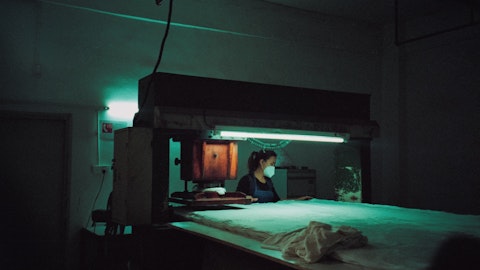Nigel Coe: Okay. And just on the CapEx. It just seems like it’s a $60 million increase. Just wanted to — I just verify that. But maybe you can talk — can we just dig into the EMEA/LA segment. The margins have been struggling for so long now. And we’ve got installation growth in orders and backlog, but inflation is down 5% this quarter. So, I’m just wondering, if you could just maybe just talk about what the problems are in that region and what some of the fixes are?
Olivier Leonetti: So we see no structural reasons for the EMEA/LA margin to be double digits. And we expect margin to turn positive in Q2. Clearly, we have work to do in the region. The margin profile of the region is mainly due to the realization of lower margin orders into the revenue. We see that turning the other way, so turning positive in Q2, Nigel.
Operator: Thank you. And our next question today comes from Andy Kaplowitz with Citigroup. Please go ahead.
Andy Kaplowitz: Hi, good morning, everyone.
Olivier Leonetti: Good morning.
Andy Kaplowitz: So your orders accelerated slightly actually in Q4, up 9%, I think, for Building Solutions led by North America. And I know you talked about the strength already and Applied and in markets such as data centers. But as you know, some leading indicators of non-res have been a little weaker. So do you see order growth holding up here across your businesses throughout FY ’24? And do you see your backlog staying around that $12.1 billion number for your long-cycle businesses in ’24? I think any incremental color would be helpful.
George Oliver: Yes, I do, Andy, when we look at — we’ve got a pretty robust tracking across all of the critical markets across the regions, and we’re tracking not only lead generation to conversion to where we’re positioning to deploy our resources and differentiate and ultimately win. So the pipeline generation has continued to be very strong, and it’s in line with what I previously discussed as far as the segments that are driving that. And I think as we look at our service business, that’s on the — when you think about new projects and new opportunities to build install. So that has been very strong. And what we’re also seeing is that on the service side, with the work that we’ve been doing with not only going back into the installed base, getting connectivity, getting use of the data and then bringing forward new value propositions.
We’re seeing significant pickup in our PSAs and being able to get longer-term contracts and build the base there. So, in spite of — when you look — when you segment our Building Solutions, whether it be installed, still strong, and then our ability to be able to, even in an economic decline, we should — with the value proposition that we’re bringing to our customers within service, I believe that that’s going to continue to hold up. And so right now, there’s no even though we look at the same metrics you look at, dodge starts and ABI and all of the key metrics being a little bit weaker, at the end of the day, with the with the way that we prioritized our growth and how we’re deploying our resources, we’re positioned to capitalize on where the growth will occur.
Andy Kaplowitz: That’s very helpful. And then maybe you could give us just a little more color on your expectations for Global Products. Do you see global residential markets, for instance, turning positive in the second half? And as the greater segment turns, how are you thinking about the European heat pump market? I think you mentioned GP stabilizing overall in the second half, but maybe you can talk about your confidence level that destocking ends in the second quarter, as you guys mentioned?
George Oliver: Let’s start with resi. As we look at the US resi market, obviously, there was challenges that set up for resi in 2023, both in units as well as overall sales with the recession. I think when we look at the reason for that, it’s higher cost equipment, it’s weaker consumer spending. It’s now people going back to work and reducing their home improvement spending. So a lot of contributors to that. I do believe that as we look at the transition here with the refrigerant changes, we get into more stabilization, where although there will be less units, certainly with the new refrigerant launches, that’s going to demand more price because of the refrigerant. And so on a sales basis, I think we’re extremely well positioned now to be able to deliver our portfolio of refrigerant changes in time for the implementation on January 1.
We have pulled ahead our new product interactions by as much as two or three months to ensure that we’re giving our distributors enough time to rebalance their inventory and ultimately restock with the new 454B refrigerant products. And again, we’re working with all of our constituents right from the suppliers to our distributors to partners to make sure we have a smooth transition. So we do believe it normalizes and somewhat stabilizes going forward. And that’s on the resi in North America. When you — your question around heat pumps, I think we believe across our portfolio, that creates an incredible opportunity for us. We believe it’s about a $100 billion market. that’s grown mid-single-digits. And today, we assess our portfolio, it’s about one-third of our sales within HVAC, are heat pumps.
And I do believe, although we’ve seen a pullback in Europe, and it’s mainly around our JCH product that we were planning for a pretty significant pick up here, 2023, which ultimately didn’t materialize that maybe that’s just kind of pushed to the right a bit as some of the countries in Europe have pushed forward the implementation date and the like. And then as a result, I think consumers have pulled back and not ultimately capitalizing on the efficiency that the heat pumps represent to them. And so we’re watching that closely. But I do believe that over the next — maybe it’s 18, 24 months, that will come back and come back pretty strong. And then on the commercial side, pretty much globally. We do have a leading portfolio. We’re understanding now with the focus on decarbonization and sustainability that we are uniquely positioned with low GWP refrigerants across our portfolio.
And we’re positioned to now capitalize on that being a significant strength as we’re capitalizing on some of the key markets globally. So that’s kind of an assessment as I think about where we are with heat pumps.




